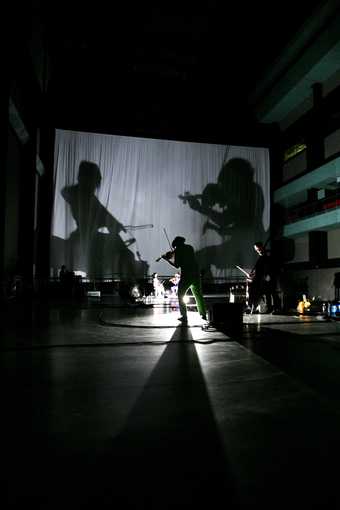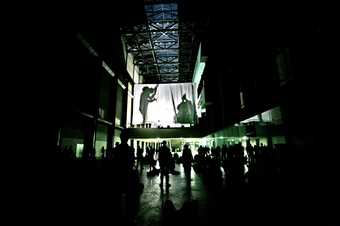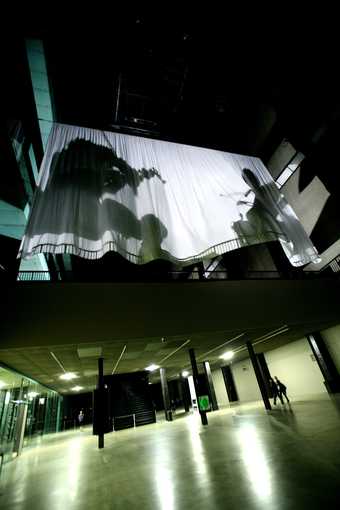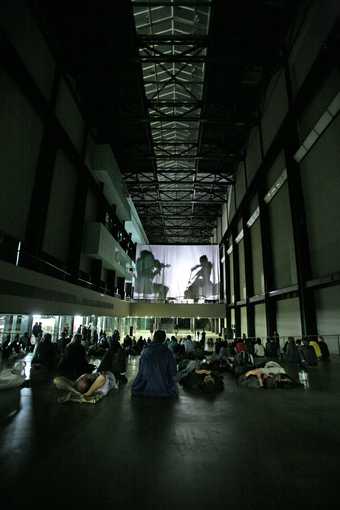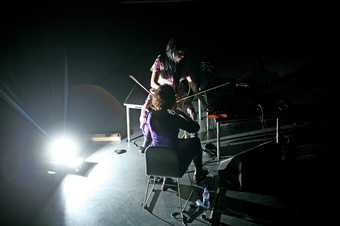On the 14 June 2008 Tate Modern’s Turbine Hall was taken over by a large-scale performance piece by the American experimental, multi-media artist Tony Conrad. Unprojectable: Projection and Perspective, was commissioned as part of UBS Openings: Saturday live, a series of bi-monthly live performance events at Tate focusing on contemporary cultural practice. It was also the focal point of a weekend long retrospective of Conrad’s work at Tate between 13–15 June, focused on artworks dating from the 1960s. A pivotal figure in contemporary culture, Conrad’s work has influenced and redefined music, filmmaking, performance, video and conceptual art, blending and deconstructing these practices through experiments in art production and engagement. Known for stroboscopic, psychedelic works that challenge audience perception and endurance, this new performance was no different in its radical approach. Staged across the Turbine Hall’s central bridge, Unprojectable: Projection and Perspective incorporated elements of sound, performance, projection, film and installation on a grand scale, creating an intense, pressure-filled auditory and visual environment.
Inspired by the hum of the former power station’s one remaining generator, the performance began with a tremendous buzzing sound, relayed by speakers placed throughout the Turbine Hall and which could be felt pulsing through the floor. Afterwards the low amplified sound of two small motors was introduced, adding to the sense of unease. The performers generating this sound were concealed behind a huge billowing sheet of material, strung across the platform of the Turbine Hall bridge. The figures were then backlit and revealed as towering shadows on the cloth, as they completed a series of audio and visual experiments. As Conrad drilled into a roll of 16mm film that was running through a projection spool, industrial noises played through the speakers. Conrad had developed this process of boring holes into raw film stock in the 1970s, and in this performance he also drilled into a series of phonograph records as an alternative means of ‘playing’ or creating music from the vinyl disks. The shrieking sounds created by this treatment of the records was amplified and projected throughout the Turbine Hall while an assistant at the side of the stage projected the drilled film onto the screen. Bright light penetrated the holes, so that the persistent, painful sounds of the records, which continued to rise in both pitch and volume, were accompanied by a relentless flickering. After around half an hour, a number of string instruments, played by Conrad and three other musicians, were added to the composition and amplified throughout the space. Their discordant tones added to the sonic assault. Throughout Conrad’s figure loomed over the audience; his silhouette creating the appearance of a mad scientist at work.
Unprojectable: Projection and Perspective, lasted for seventy-one minutes and like Conrad’s renowned 1966 experimental film work, The Flicker tested the audience’s endurance, linking the viewer’s experience and that of the maker. This work brought together theatre, performance and film, and made the creative process part of it. By amplifying, exaggerating and scaling up the visual and audible elements of the piece and focusing on the material and mechanical potentials of his artistic implements, with Unprojectable: Projection and Perspective, Conrad pushed not only the limits of spectatorship but of artistic practice itself.
Clare Gormley
June 2016

